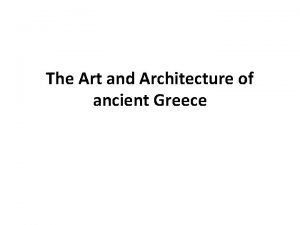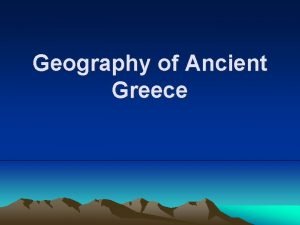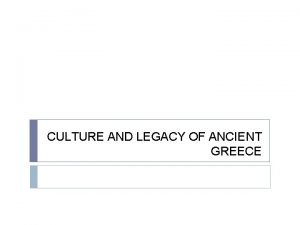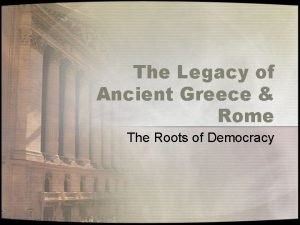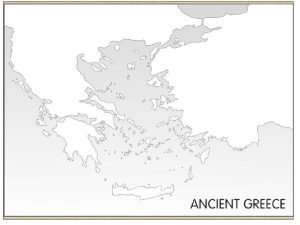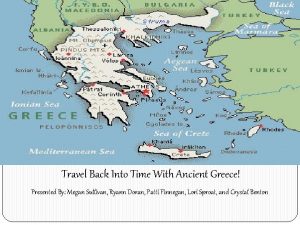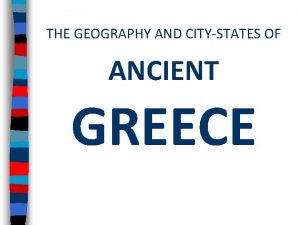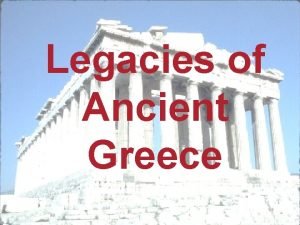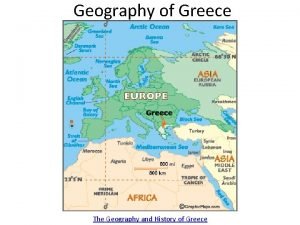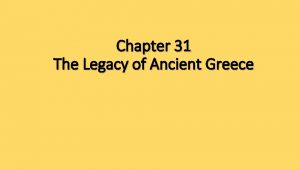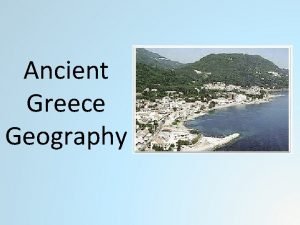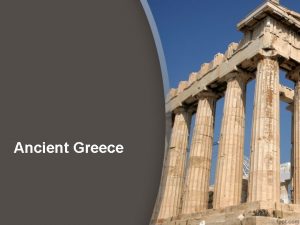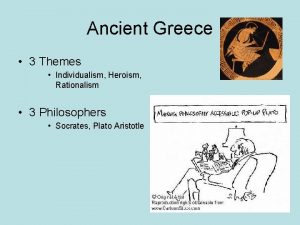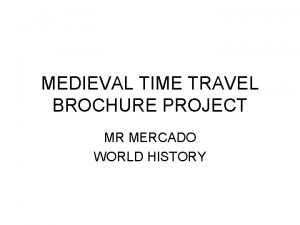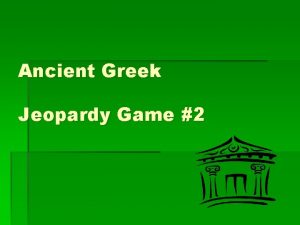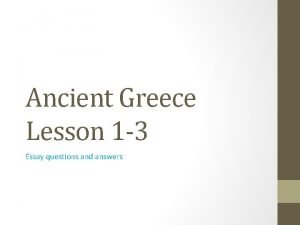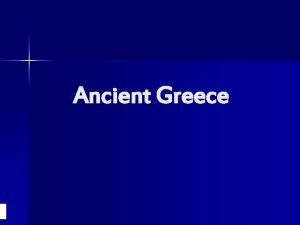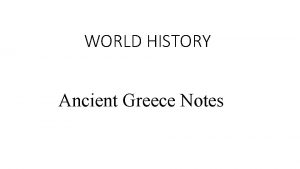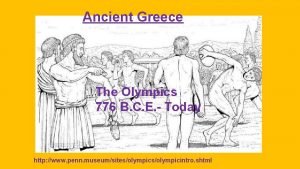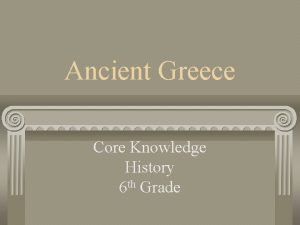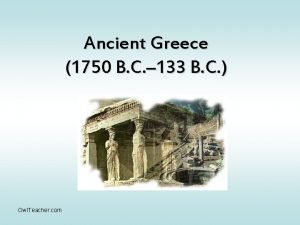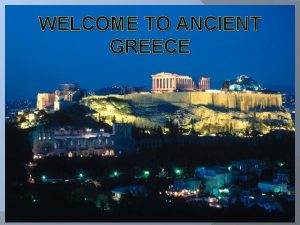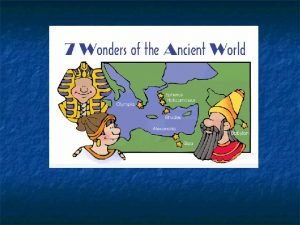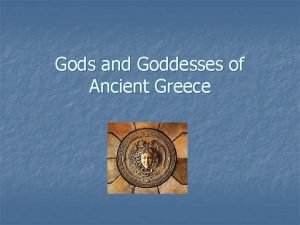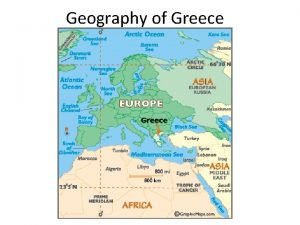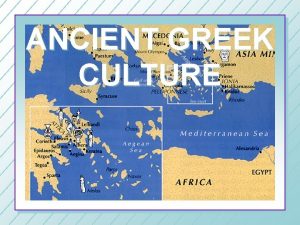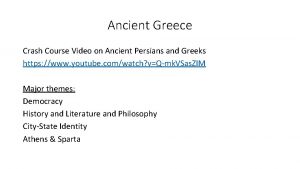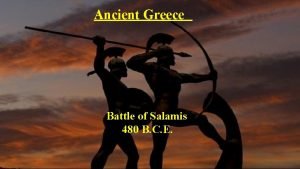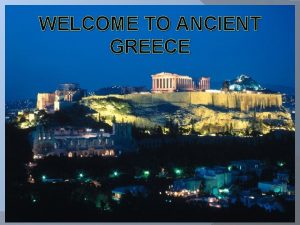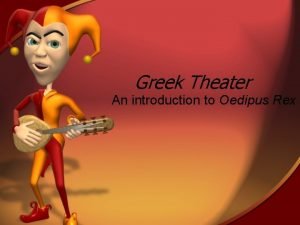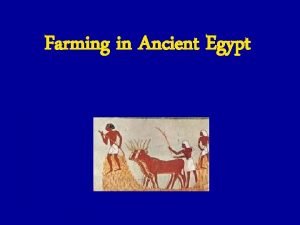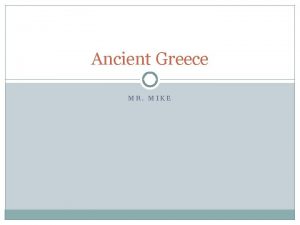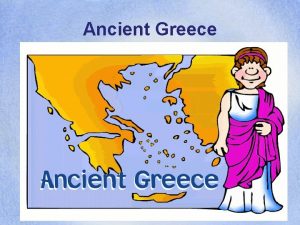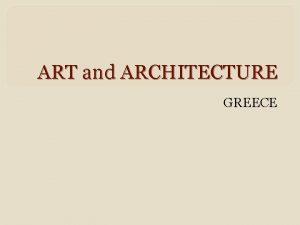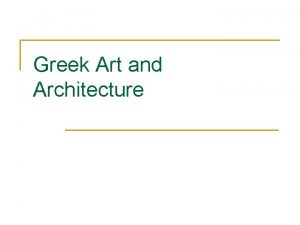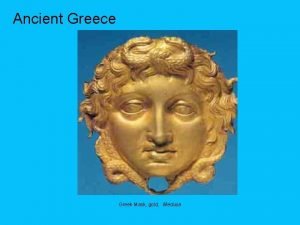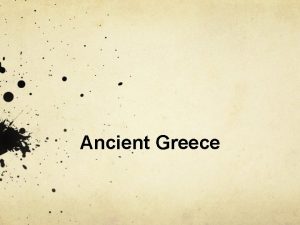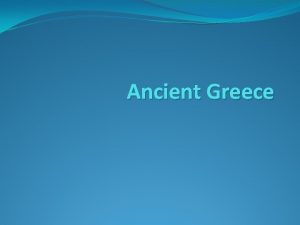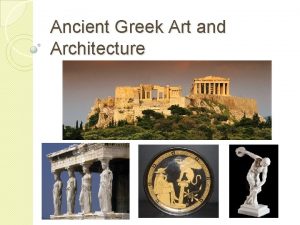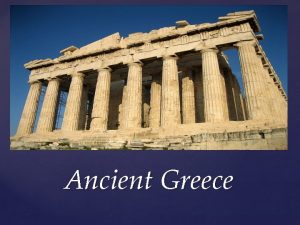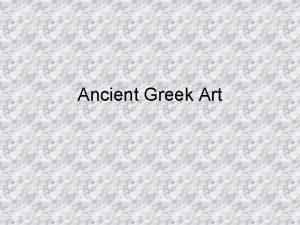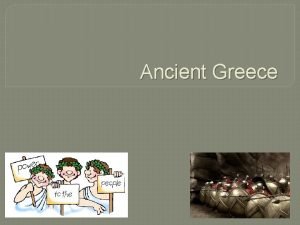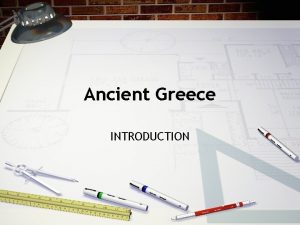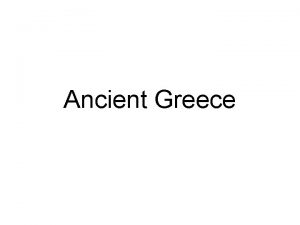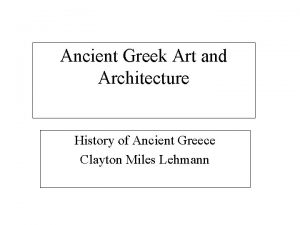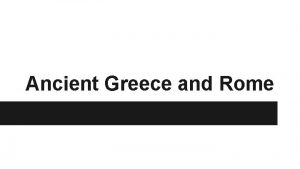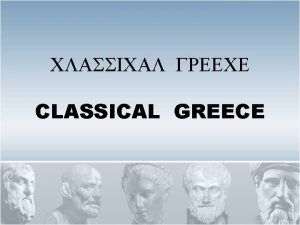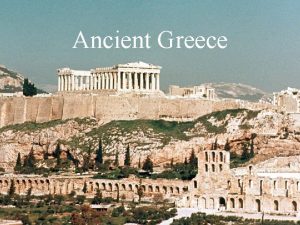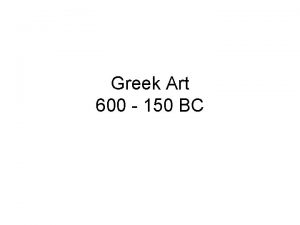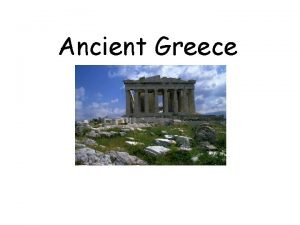The Art and Architecture of ancient Greece Greek









































![The Erectheum The Porch of the Caryatids[edit] On the north side, there is another The Erectheum The Porch of the Caryatids[edit] On the north side, there is another](https://slidetodoc.com/presentation_image/2675595c21b3d787089ec8d333820f18/image-42.jpg)








- Slides: 50

The Art and Architecture of ancient Greece

Greek Architecture, defined as building executed to an aesthetically considered design, was extinct in Greece from the end of the Mycenaean period (about 1200 BC) to the 7 th century BC, when urban life and prosperity recovered to a point where public building could be undertaken. But since many Greek buildings in the colonization period (8 th - 6 th century BC), were made of wood or mud-brick or clay, nothing remains of them except for a few ground-plans, and almost no written sources on early architecture or descriptions of these embryonic buildings exist.

Architectural History Around 600 BC, the wooden columns of the old Temple of Hera at Olympia underwent a material transformation, known as "petrification", in which they were replaced by stone columns. By degrees, other parts of the temple were petrified until the entire temple was made of stone. With the spread of this process to other sanctuaries, Greek temples and significant buildings from the 6 th century BC onwards were built largely from stone, and a few fortunate examples have survived through the ages. Most of our knowledge of Greek architecture comes from the late archaic period (550 - 500 BC), the Periclean age (450 - 430 BC), and the early to pure classical period (430 - 400 BC). Greek examples are considered alongside Hellenistic and Roman periods (since Roman architecture heavily copied Greek), and late written sources such as Vitruvius (1 st century). This results in a strong bias towards temples, the only buildings which survive in numbers.

Structure and style of Greek temples The standard format of Greek public buildings is known from surviving examples such as the Parthenon and the Hephaesteum at Athens. Most buildings were rectangular and made from limestone or tufa. Marble was used mainly for sculptural decoration, not structurally, except in the very grandest buildings of the Classical period such as the Parthenon. The basic rectangular plan was surrounded by a colonnaded portico of columns on all four sides (peripteral or peristyle) such as the Parthenon, and occasionally at the front and rear only (amphiprostyle) as seen in the small Temple of Athena Nike. Some buildings had projecting columns forming the entrance (prostyle), while others featured a pronaos facade of columns leading on to the cella. The Greeks roofed their buildings with timber beams covered with overlapping terra cotta or occasionally marble tiles. They understood the principles of the masonry arch but made little use of it, and did not put domes on their buildings these elaborations were left to the Romans.

Pediment and Entablature. The low pitch of the gable roofs produced a squat triangular shape at each end of the building, the Pediment, which was typically filled with sculptural decoration. Between the roof and the tops of the columns a row of lintels formed the entablature, whose outward-facing surfaces also provided a space for sculptures, known as friezes The frieze consisted of alternating metopes (holding the sculpture) and triglyphs. No surviving Greek building preserves these sculptures intact, but they can be seen on some modern imitations of Greek buildings, such as the Greek National Academy building in Athens

Greek Public Architecture The temple was the most common and best-known form of Greek public architecture. The temple did not serve the same function as a modern church. For one thing, the altar stood under the open sky in the temenos or sacred fane, often directly before the temple. Temples served as storage places for the treasury associated with the cult of the god in question, as the location of a cult image sometimes of great antiquity, but from the time of Pheidias often a great work of art as well. The temple was a place for devotees of the god to leave their votive offerings, such as statues, helmets and weapons. The inner room of the temple, the cella, thus served mainly as a strongroom and storeroom. It was usually lined by another row of columns.

Other architectural forms used by the Greeks were tholos or circular temple, of which the best example is the Tholos of Theodorus at Delphi dedicated to the worship of Athena Pronaia; the propylon or porch, forming the entrance to temple sanctuaries (the best-surviving example is the Propylaea on the Acropolis of Athens); the fountain house, a building where women filled their vases with water from a public fountain; and the stoa, a long narrow hall with an open colonnade on one side, which was used to house rows of shops in the agoras (commercial centres) of Greek towns also needed at least one bouleuterion or council chamber, a large public building which served as a court house and as a meeting place for the town council (boule). Because the Greeks did not use arches or domes, they could not construct buildings with large interior spaces. The bouleuterion thus had rows of internal columns to hold the roof up (hypostyle). No examples of these buildings survive.

City Planning and Houses The Greeks had begun to lay out cities in a grid-like pattern before the start of the Classical period in the early 5 th century BC, with streets regularly intersecting at right angles. Yet the Greeks credited the invention of the right-angled plan to Ionian architect Hippodamus. He planned new cities for Piraeus and the Athenian colony of Thuril. The late 5 th century Olynthus showed his influence in the city's uniform streets and blocks. By the 4 th century BC, carefully planned cities and civic spaces had become common in the Greek city states.

The Theatre Finally, every Greek town had a theatre. These were used for both public meetings as well as dramatic performances. These performances originated as religious ceremonies; they went on to assume their Classical status as the highest form of Greek culture by the 6 th century BC. The theatre was usually set in a hillside outside the town, and had rows of tiered seating set in a semi-circle around the central performance area, the orchestra. Behind the orchestra was a low building called the skene, which served as a store-room, a dressing -room, and also as a backdrop to the action taking place in the orchestra. A number of Greek theatres survive almost intact, the best known being at Epidaurus

The restored Stoa of Attalus, Athens The reconstructed Stoa of Attalos, the Agora, Athens

The Theatre and Temple of Apollo in mountainous country at Delphi Every Greek town had an open-air theatre. These were used for both public meetings as well as dramatic performances. The theatre was usually set in a hillside outside the town, and had rows of tiered seating set in a semicircle around the central performance area, the orchestra. Behind the orchestra was a low building called the skênê, which served as a store-room, a dressing-room, and also as a backdrop to the action taking place in the orchestra

Pebble mosaic floor of a house at Olynthus, depicting Bellerophon is a hero of Greek mythology. He was "the greatest hero and slayer of monsters, alongside Cadmus and Perseus, before the days of Heracles", [1] whose greatest feat was killing the Chimera, a monster that Homer depicted with a lion's head, a goat's body, and a serpent's tail: "her breath came out in terrible blasts of burning flame. "

The Acropolis, Athens, is high above the city on a natural prominence. The Acropolis' construction started in 447 BC and ended in 438 BC. The Parthenon was the temple of the Greek Goddess Athena. During the Classical Period the Parthenon, the Erechtheion, and the Temple of Nike were built over the old ruins on The Acropolis.


The Islands of the Aegean from Cape Sounion with the Temple of Poseidon. The temple overlooks the Aegean sea, so named because King Aegeus threw himself into the sea from this point when he thought his son was dead. The temple's location was important because every boat coming to Athens passed by this point.

Delos cubic floor mosaic A cubic floor mosaic in a house on the Greek island of Delos.

Epidaurus Stadium The asclepieion at Epidaurus was the most celebrated healing center of the Classical world, the place where ill people went in the hope of being cured. To find out the right cure for their ailments, they spent a night in the enkoimeteria, a big sleeping hall. In their dreams, the god himself would advise them what they had to do to regain their health. Found in the sanctuary, there was a guest house for 160 guestrooms. There also mineral springs in the vicinity which may have been used in healing.

Golden spiral in rectangles.

Greek street – III century BC. Greek street - IV-III century BC - Porta Rosa - Velia - Italy The Porta Rosa road was the main street of Elea. It connects the northern quarter with the southern quarter, through the viaduct called Porta Rosa. The street is 5 meters wide and has an incline of 18 % in the steepest part. It is paved with limestone blocks, girders cut in square blocks, and on one side a small gutter for the drainage of rain water. The building is dated during the time of the reorganization of the city during Helenistic age (IV -III century BC)

The House of Masks Delos The island of Delos , near Mykonos, near the centre of the Cyclades archipelago, is one of the most important mythological, historical and archaeological sites in Greece.

The House of Masks Delos The island of Delos, near Mykonos, near the centre of the Cyclades archipelago, is one of the most important mythological, historical and archaeological sites in Greece.

Model of ancient Olympia This model represents the Temple of Olympian Zeus in Athens which was one of the largest temples in ancient Greece.

Palaestra at Olympia is an ancient edifice in Olympia, Greece, Part of the gymnasium at thesanctuary. It is a sixty-six metre square building dates to the end of the third or beginning of the 2 nd century BC. It was a building in ancient Greece devoted to the training of wrestlers and other athletes.

The Parthenon is a temple on the Athenian Acropolis, dedicated to the maiden goddess Athena, whom the people of Athens considered their patron deity. Its construction began in 447 BC. It was completed in 438 BC, although decoration of the building continued until 432 BC. It is the most important surviving building of Classical Greece,

Priene Bouleuterion A bouleuterion was a building which housed the council of citizens ( boule) in Ancient Greece. There are several extant remains of Bouleuterions around Greece and former Greek territories of ancient times. The boule, a basic institution of the ancient city-state in historical times, consisted of the citizens' representatives who assembled in order to confer and decide about public affairs. The word Bouleuterion is composed from Greek 'boule' (council) and the suffix -terion (place for doing something).

The Altar of Hiero II at Syracuse The altar of Zeus Eleutherios (the Liberator) was constructed by Hieron II, tyrant of Syracuse, as part of his building program in this area; it is approximately contemporaneous with the nearby theater and nymphaeum. Diodorus states that 450 oxen were able to be sacrificed simultaneously atop the altar during the annual feast of Zeus Eleutherios. Despite its enormous length (600 Doric feet; ca. 196 m), the altar was quite narrow and it stood ca. 11 m high. Narrow stairways were located at each end of the front, flanked by telamones.

Theatre of Dionysus Eleuthereus Greek theaters in antiquity were in many instances of huge proportions but, under ideal conditions of occupancy and weather, the acoustical properties approach perfection by modern tests. We know that theater of Dionysus in Athens could seat 17, 000 spectators

Temple of Hephaistos It was dedicated to Hephaestus, the god of smiths and metal-workers. It was also erroneously know as Thissio (temple of Theseus).

Temple of Hephaistos Detail of Doric column base It was dedicated to Hephaestus, the god of smiths and metal-workers. It was also erroneously know as Thissio (temple of Theseus).

Temple of Hephaistos Detail of Capitals

House on the island of Delos. Typical plan The houses of the island of Delos give an accurate picture of the private home Hellenistic one. The houses form the vast majority of buildings excavated at Delos in a good state of preservation.

Athena Parthenos Recreation of the colossal statue of Athena, once housed in the Parthenon, with sculptor Alan Le. Quire

Gargoyle The lion's head gargoyle is fixed to a revetment on which elements of a formal frieze have been painted.

Black figure Amphora, Atalante painter (500 -490 BC), shows proportion and style that are hallmarks of Ancient Greek art Black figure Amphora, Atalante painter (500 -490 BC), shows proportion and style that are hallmarks of Ancient Greek art

The lion's head gargoyle is fixed to a revetment on which elements of a formal frieze have been painted. Early wooden structures, particularly temples, were ornamented and in part protected by fired and painted clay revetments in the form of rectangular panels, and ornamental discs

Classical Orders The Doric order is the oldest and simplest of the classical orders. It is composed of a vertical cylinder that is wider at the bottom. It generally has neither a base nor a detailed capital

Doric Order Parts of an Ancient Greek temple of the Doric Order: 14. Capital 15. Abacus 16. Echinus 17. Column 18. Fluting

Pediment of the Parthenon (part) The left hand group of surviving figures from the East Pediment of the Parthenon, exhibited as part of the Elgin Marbles in the British Museum.

Ionic Order-Erechthium Corner capital with a diagonal volute, showing also details of the fluting separated by fillets.

Frieze of stylised alternating palms and reeds, and a cornice decorated with "egg and dart" moulding.

Caryatids A caryatid is a sculpted female figure serving as an architectural support taking the place of a column or a pillar supporting an entablature on her head. The Greek term karyatides literally means "maidens of Karyai", an ancient town of Peloponnese. Karyai had a famous temple dedicated to the goddess. Artemis in her aspect of Artemis Karyatis: "As Karyatis she rejoiced in the dances of the nut-tree village of Karyai, those Karyatides, who in their ecstatic round-dance carried on their heads baskets of live reeds, as if they were dancing plants" (Kerenyi 1980 p 149).
![The Erectheum The Porch of the Caryatidsedit On the north side there is another The Erectheum The Porch of the Caryatids[edit] On the north side, there is another](https://slidetodoc.com/presentation_image/2675595c21b3d787089ec8d333820f18/image-42.jpg)
The Erectheum The Porch of the Caryatids[edit] On the north side, there is another large porch with six Ionic columns, and on the south, the famous "Porch of the Maidens", with six draped female figures (caryatids) as supporting columns. The porch was built to conceal the giant 15 -ft beam needed to support the southwest corner over the metropolis, after the building was drastically reduced in size and budget following the onset of the Peloponnesian war.

Erechtheion: masonry, door, stone lintels, coffered ceiling panels

Corinthian Order The capital combines both semi-naturalistic leaves and highly stylised tendrils forming volutes.

Temple of Hephaestos The Temple of Hephaestos, Athens, is a well-preserved temple of peripteral hexastyle plan.

Capital of the Ionic Order showing volutes and ornamented echinus

Corinthian Order Capital of the Corinthian Order showing foliate decoration and vertical volutes.

The Parthenon, shows the common structural features of Ancient Greek architecture: crepidoma, columns, entablature, pediment.

The Temple of Zeus Olympia, Athens. The Temple of Zeus at Olympia was an ancient Greek temple in Olympia, Greece, dedicated to the chief of the gods, Zeus. The temple, built between 472 and 456 BC, was the very model of the fully developed classical Greek temple of the Doric order. [1]

Temple of Aphaia At the Temple of Aphaia the hypostyle columns rise in two tiers, to a height greater than the walls, to support a roof without struts.
 Greece art and architecture
Greece art and architecture Greek theater architecture
Greek theater architecture Greek paintings characteristics
Greek paintings characteristics Greek philosophers of physical education
Greek philosophers of physical education Where was ancient greece located on a map
Where was ancient greece located on a map Ancient greece stations
Ancient greece stations The legacy of ancient greece and rome
The legacy of ancient greece and rome Adriatic sea ancient greece map
Adriatic sea ancient greece map Where was ancient greece located
Where was ancient greece located Ancient greece contributions
Ancient greece contributions Geography of greece
Geography of greece The legacy of ancient greece
The legacy of ancient greece Where was sparta located
Where was sparta located Legacy of ancient greece
Legacy of ancient greece Greek music instrument
Greek music instrument Greek cultural values
Greek cultural values Which continent is ancient greece located
Which continent is ancient greece located 8
8 Where is the balkan peninsula in ancient greece
Where is the balkan peninsula in ancient greece Balkan peninsula in ancient greece
Balkan peninsula in ancient greece Balkan peninsula ancient greece map
Balkan peninsula ancient greece map School of athens individualism
School of athens individualism Who wrote the republic in ancient greece
Who wrote the republic in ancient greece Ancient greece travel brochure project
Ancient greece travel brochure project Ancient greece jeopardy
Ancient greece jeopardy Ancient greece essay topics
Ancient greece essay topics Ancient greece peninsula
Ancient greece peninsula Greek map
Greek map Greek drama masks
Greek drama masks Ancient greece
Ancient greece Core knowledge ancient greece
Core knowledge ancient greece Ancient greece 1750 b.c-133 b.c answers
Ancient greece 1750 b.c-133 b.c answers Abcs of greece
Abcs of greece 7 wonders of ancient greece
7 wonders of ancient greece Greece map
Greece map Saturn cronos
Saturn cronos Ancient greece balkan peninsula
Ancient greece balkan peninsula How was tyranny practiced in ancient greece
How was tyranny practiced in ancient greece Aristocrats in ancient greece
Aristocrats in ancient greece Ancient olympic ceremonies
Ancient olympic ceremonies Ancient greece
Ancient greece Humanism in ancient greece
Humanism in ancient greece Ancient greece crash course
Ancient greece crash course Salamis ancient greece map
Salamis ancient greece map How was tyranny government practiced in ancient greece
How was tyranny government practiced in ancient greece Describe the geography of ancient greece
Describe the geography of ancient greece Legacies of ancient greece
Legacies of ancient greece Fun facts for greece
Fun facts for greece Map ancient greece
Map ancient greece Ancient greece webquest
Ancient greece webquest What crops did ancient greece grow
What crops did ancient greece grow
